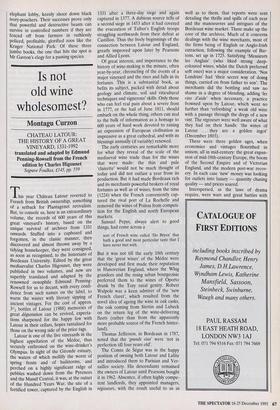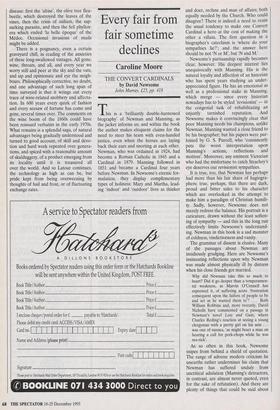Is not old wine wholesomest?
Montagu Curzon
CHATEAU LATOUR: THE HISTORY OF A GREAT VINEYARD, 1331-1992 translated and adapted by Edmund Penning-Rowsell from the French edition by Charles Higounet Segrave Foulkes, £145, pp. 559 This year Château Latour reverted to French from British ownership, something of a setback for Plantagenet revivalists. But, to console us, here is an extraordinary volume, the records of 600 years of this great vineyard's history, based on the unique survival of archives from 1331 onwards. Stuffed into a cupboard and forgotten, in the classic manner, then discovered and almost thrown away by a tidying housekeeper, they were consigned, as soon as recognised, to the historians of Bordeaux University. Edited by the great mediaevalist Charles Higounet, they were published in two volumes, and now are superbly translated and adapted by the renowned oenophile Edmund Penning- Rowsell for us to decant, with every confi- dence from such names on the label, to warm the winter with literary sipping of ancient vintages. For the cost of approx. 31/2 bottles of Latour (1988) memories of great &gustation can be revived, expecta- tions sharpened for the happy few with Latour in their cellars, hopes tantalised for those on the wrong side of the price tags.
Latour is one of the five vineyards in the highest appellation of the Medoc, thus securely enthroned on the wine-drinker's Olympus. In sight of the Gironde estuary, the waters of which mollify the worst of spring frosts and of hailstorms, and perched on a highly significant ridge of pebbles washed down from the Pyrenees and the Massif Central, it was, at the outset of the Hundred Years War, the site of a fortified tower, captured by the English in 1331 after a three-day siege and again captured in 1377. A dubious source tells of a second siege in 1453 after it had covered the evacuation of Talbot's English troops straggling northwards from their defeat at Castillon. Thus the lively beginnings of the connection between Latour and England, greatly improved upon later by Pearsons and Allied Lyons.
Of great interest, and importance to the history of wine-making is the minute, often year-by-year, chronicling of the events of a major vineyard and the rises and falls in its fortunes. This is a substantial book, as befits its subject, packed with detail about geology and climate, soil and viticultural techniques and vignerons' skills. Only those who can feel real pain about a severe frost in 1777, or the hail of June 1811, should embark on the whole thing, others can nod to the bulk of information as a homage to 600 years of hard work devoted to raising an expression of European civilisation as impressive as a great cathedral, and with its blessings annually (if variably) renewed.
The early centuries are remarkable more for what they reveal of the scale of the mediaeval wine trade than for the wines that were made: the thin and pale `clairette' would not be much thought of today and did not outlast a year from its production. But it had made Bordeaux rich and its merchants powerful brokers of royal fortunes as well as of wines, from the time (1224) when the French conveniently cap- tured the rival port of La Rochelle and removed the wines of Poitou from competi- tion for the English and north European markets.
Samuel Pepys, always alert to good things, had come across a
sort of French wine called 'Ho Bryen' that hath a good and most perticular taste that I have never met with.
But it was not till the early 18th century that the 'great wines' of the Medoc were developed and first made their reputation in Hanoverian England, where the Whig grandees and the rising urban bourgeoisie preferred them to the wines of Oporto drunk by the Tory rural gentry. Robert Walpole was a keen admirer of the 'new French claret', which resulted from the novel idea of ageing the wine in oak casks, the oak coming from Stettin and Lubeck on the return leg of the wine-delivering fleets (rather than from the apparently more probable source of the French hinter- land).
Thomas Jefferson, in Bordeaux in 1787, noted that the `grands vins' were 'not in perfection till four years old'.
The Comte de Segur was in the happy position of owning both Latour and Lafite and introduced them to Parisian and Ver- sailles society. His descendants remained the owners of Latour until Pearsons bought it in 1962. Absentee, if often highly compe- tent landlords, they appointed managers, regisseurs, with the result useful to us as well as to them, that reports were sent detailing the thrills and spills of each year and the manoeuvres and intrigues of the Bordeaux wine market. These make up the core of the archives. Much of it concerns dealings with the wine merchants, most of the firms being of English or Anglo-Irish extraction, following the example of Bar- tons, set up in 1725. Satisfying 'Messieurs les Anglais' (who liked strong deep- coloured wines, whilst the Dutch preferred soft ones) was a major consideration. 'Nos Londrins' had 'their secret way of doing things, carried on from father to son'. The merchants did the bottling and saw no shame in a degree of blending, adding les vins d'aide' when necessary, a practice frowned upon by Latour, which went no further than 'refreshing' a weak old wine with a passage through the dregs of a new vint. The regisseurs were well aware of what they had on their hands: 'the wines of Latour . . . they are a golden ingot' (December 1803).
There were three golden ages, when economies and vintages flourished in unison, all in mid-century: the great expan- sion of mid-18th-century Europe, the boom of the Second Empire and of Victorian England, and the modern post-war recov- ery. In each case 'new' money was looking for outlets into luxury — quantity chasing quality — and prices soared.
Interspersed, as the laws of drama require, were wars and great battles with disease: first the 'altise', the olive tree flea- beetle, which destroyed the leaves of the vines, then the crisis of oidium, the sap- sucking parasite, and then the fell phyllox- era which ended 'la belle époque' of the Medoc. Occasional invasions of snails might be added.
There is a poignancy, even a certain graveyard chill, in reading of the anxieties of these long-swallowed vintages. All gone, wine, throats, and all, and every year we worry still and peer at the sky and the vats, and sip and opinionate and eye the neigh- bours. Philosophically corrective, no doubt, and one advantage of such long span of time surveyed is that it wrings out every trace of wine-related snobbery and affecta- tion. In 600 years every quirk of fashion and every seesaw of fortune has come and gone, several times over. The comments on the wine boom of the 1860s could have been reissued verbatim in the early 1970s. What remains is a splendid saga, of natural advantages being gradually understood and turned to good account, of skill and devo- tion and hard work repeated over genera- tions, and spiced with a reasonable amount of skulduggery, of a product emerging from its locality until it is treasured all over the world. And so Latour continues, the technology as high as can be, but pride kept from being overweening by thoughts of hail and frost, or of fluctuating exchange rates.











































































































 Previous page
Previous page